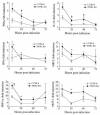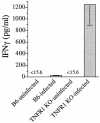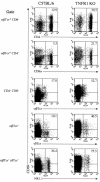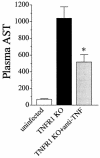Increased mortality and dysregulated cytokine production in tumor necrosis factor receptor 1-deficient mice following systemic Klebsiella pneumoniae infection
- PMID: 12933830
- PMCID: PMC187315
- DOI: 10.1128/IAI.71.9.4891-4900.2003
Increased mortality and dysregulated cytokine production in tumor necrosis factor receptor 1-deficient mice following systemic Klebsiella pneumoniae infection
Abstract
A significant clinical complication of pulmonary infections with Klebsiella pneumoniae is peripheral blood dissemination, resulting in a systemic infection concurrent with the localized pulmonary infection. In this context, little is known about the role of tumor necrosis factor receptor 1 (TNFR1)-mediated innate immune responses during systemic Klebsiella infections. Mice lacking TNFR1 were significantly more susceptible to Klebsiella-induced mortality following intravenous inoculation. Bacterial clearance was impaired in TNFR1-deficient mice at early times following infection. Unexpectedly, bacterial burdens at the onset of mortality (days 2 to 3 postinfection) were not higher in mice lacking TNFR1. However, elevated production of liver-associated proinflammatory cytokines (interleukin-12, tumor necrosis factor alpha [TNF-alpha[, and gamma interferon [IFN-gamma]) and chemokines (MIP-1 alpha, MIP-2, and MCP-1) was observed within the first 24 h of infection. Additionally, excessive plasma-associated IFN-gamma was also observed late in the course of infection (day 3). Spleen cells from day-3 infected TNFR1-deficient mice secreted markedly enhanced levels of IFN-gamma when cultured in vitro. Additionally, there was a marked increase in the total number of activated lymphocyte subsets as indicated by CD69 upregulation. A notable exception was the sharp decrease in the frequency of splenic NK T cells in infected TNFR1 knockout (KO) mice. Anti-TNF-alpha therapy in TNFR1 KO mice significantly reduced chemokine production and liver injury. Combined, these data indicate a dysregulated antibacterial host response following intravenous Klebsiella infection in the absence of TNFR1 signaling, resulting in heightened cytokine production and hyperactivation of specific splenic lymphocyte subsets.
Figures









Similar articles
-
Defective innate antibacterial host responses during murine Klebsiella pneumoniae bacteremia: tumor necrosis factor (TNF) receptor 1 deficiency versus therapy with anti-TNF-alpha.Clin Infect Dis. 2005 Aug 1;41 Suppl 3:S213-7. doi: 10.1086/430126. Clin Infect Dis. 2005. PMID: 15983903
-
Anti-tumor necrosis factor-alpha therapy during murine Klebsiella pneumoniae bacteremia: increased mortality in the absence of liver injury.Shock. 2003 Oct;20(4):309-15. doi: 10.1097/01.shk.0000087203.34916.45. Shock. 2003. PMID: 14501943
-
Gamma delta-T cells are critical for survival and early proinflammatory cytokine gene expression during murine Klebsiella pneumonia.J Immunol. 2000 Sep 1;165(5):2643-50. doi: 10.4049/jimmunol.165.5.2643. J Immunol. 2000. PMID: 10946293
-
Divergent role of gamma interferon in a murine model of pulmonary versus systemic Klebsiella pneumoniae infection.Infect Immun. 2002 Nov;70(11):6310-8. doi: 10.1128/IAI.70.11.6310-6318.2002. Infect Immun. 2002. PMID: 12379710 Free PMC article.
-
TNF-alpha-induced expression of adhesion molecules in the liver is under the control of TNFR1--relevance for concanavalin A-induced hepatitis.J Immunol. 2001 Jan 15;166(2):1300-7. doi: 10.4049/jimmunol.166.2.1300. J Immunol. 2001. PMID: 11145713
Cited by
-
Beta2-microglobulin-dependent bacterial clearance and survival during murine Klebsiella pneumoniae bacteremia.Infect Immun. 2009 Jan;77(1):360-6. doi: 10.1128/IAI.00909-08. Epub 2008 Nov 3. Infect Immun. 2009. PMID: 18981251 Free PMC article.
-
Loss of tumor necrosis factor alpha potentiates transforming growth factor beta-mediated pathogenic tissue response during wound healing.Am J Pathol. 2006 Jun;168(6):1848-60. doi: 10.2353/ajpath.2006.050980. Am J Pathol. 2006. PMID: 16723700 Free PMC article.
-
Clinical Implications of Genomic Adaptation and Evolution of Carbapenem-Resistant Klebsiella pneumoniae.J Infect Dis. 2017 Feb 15;215(suppl_1):S18-S27. doi: 10.1093/infdis/jiw378. J Infect Dis. 2017. PMID: 28375514 Free PMC article. Review.
-
A One-Nearest-Neighbor Approach to Identify the Original Time of Infection Using Censored Baboon Sepsis Data.Crit Care Med. 2016 Jun;44(6):e432-42. doi: 10.1097/CCM.0000000000001623. Crit Care Med. 2016. PMID: 26968022 Free PMC article.
-
M-CSF Mediates Host Defense during Bacterial Pneumonia by Promoting the Survival of Lung and Liver Mononuclear Phagocytes.J Immunol. 2016 Jun 15;196(12):5047-55. doi: 10.4049/jimmunol.1600306. Epub 2016 May 4. J Immunol. 2016. PMID: 27183631 Free PMC article.
References
-
- Allendoerfer, R., and G. S. Deepe, Jr. 2000. Regulation of infection with Histoplasma capsulatum by TNFR1 and -2. J. Immunol. 165:2657-2664. - PubMed
-
- Bank, U., and S. Ansorge. 2001. More than destructive: neutrophil-derived serine proteases in cytokine bioactivity control. J. Leukoc. Biol. 69:197-206. - PubMed
-
- Burwen, D. R., S. N. Banerjee, and R. P. Gaynes. 1994. Ceftazidime resistance among selected nosocomial gram-negative bacilli in the United States. National Nosocomial Infections Surveillance System. J. Infect. Dis. 170:1622-1625. - PubMed
-
- Carnaud, C., D. Lee, O. Donnars, S. H. Park, A. Beavis, Y. Koezuka, and A. Bendelac. 1999. Cross-talk between cells of the innate immune system: NKT cells rapidly activate NK cells. J. Immunol. 163:4647-4650. - PubMed
-
- Chosay, J. G., N. A. Essani, C. J. Dunn, and H. Jaeschke. 1997. Neutrophil margination and extravasation in sinusoids and venules of liver during endotoxin-induced injury. Am. J. Physiol. 272:G1195-G1200. - PubMed
Publication types
MeSH terms
Substances
Grants and funding
LinkOut - more resources
Full Text Sources
Research Materials
Miscellaneous

